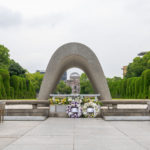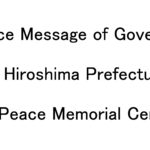Roses in Hiroshima Peace Memorial Park Vol.3

Anne Frank is a famous name everyone has heard at least once. In the Netherlands during World War II, a young girl was confined to a short life by war. Have you ever imagined that there are roses in the Peace Memorial Park dedicated to her? This time we will talk about Anne Frank’s rose.
Anne Frank
During World War II, most of Western Europe was occupied by Nazi Germany. In those areas, Nazi anti-Semitism led to the Holocaust, the extermination of the Jews. In the midst of this, the family of Anne Frank, a young Jewish-German girl, lived in a blackout in the Netherlands.
They lived there for two years, during which time Anne kept a diary. In 1944, the Nazis finally discovered the hideaway. Anne and her sister were sent to a concentration camp, where she fell ill in unsanitary conditions and lived a short life of 15 years.
After the war, Anne’s father Otto, decided to publish his daughter’s diary in the hope that the world would be free of war and discrimination. The Diary of a Young Girl has been translated into more than 60 languages and has become a worldwide bestseller, over 25 million copies sold.

Anne’s rose
There is a rose named after Anne Frank, and it is planted in Hiroshima’s Peace Memorial Park.
In 1955, the Belgian breeder Hippolyte Delforge created a new hybrid rose. After becoming acquainted with Anne’s father, Otto, he offers to devote the most beautiful rose he has ever produced as a memento of Anne. In 1960, the rose was registered under the name Souavenir d’Anne Frank.
Anne’s rose is red in bud, golden when in bloom, and turns salmon pink to red when exposed to sunlight. It is said to represent Anne’s own potential for a different future if she had survived.
Anne’s rose was entrusted by Otto to OTSUKI Michiko, a member of the Holy Ecclesia of Jesus in Japan, with a wish for peace, and was propagated at the Kyoto Holy Ecclesia of Jesus Sagano Church in 1973. It was later donated to the city of Hiroshima by relatives of Ms. Otsuki in 1989. Wishing for peace, roses in Anne’s name were introduced to many people.
Anne Frank’s “memento” roses are now planted in the Peace Memorial Park in a flower bed in front of the Children’s Peace Monument. They also grow in the rose garden of the Holocaust Memorial Museum in Miyuki-cho Fukuyama City, where the roses are turning colours in the hope for peace.
Peace Memorial Park
address: 1-1 Nakajimacho, Naka ward, Hiroshima City (the rose garden is at the location of the red pin on the map above)
Phone No.: +81 (0)82-504-2390
WebPage http://hpmmuseum.jp/ (Hiroshima Peace Memorial Museum)

Address: 815 Nakatsuhara, Miyuki, Fukuyama-City,
Tel: +81 (0)84 955 8001
Free administration
Opening hours: Tuesday to Saturday, 10:30 a.m. – 4:30 p.m.
(Closed on Sunday, Monday, National Holidays and Aug.13-16, Dec.27-Jan.5)
Roses in Hiroshima Peace memorial park vol1
Roses in Hiroshima Peace memorial park vol2
Introducing the Peace Study Project
Reconstruction Support from Overseas
When the atomic bomb was dropped on Hiroshima, various kinds of support were delivered from overseas.This “support from overseas” encouraged the struggling citizens of Hiroshima both physically and spiritually.
Reconstruction Support from Overseas
Tags associated with this article






-1-150x150.jpg)

